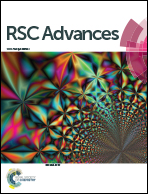DFT investigation on the selective complexation of ionic liquids based on α-amino acid anion and N7,N9-dimethyladeninium cation with CO2†
Abstract
A series of aliphatic amino acid ionic liquids (AAILs) composed of N7,N9-dimethyladeninium cation with an amino acid anion as the functionalized ILs, with dual amine group, have been designed for CO2 capture. The most possible adsorption mechanisms were investigated. Based on the obtained data, CO2 is chemically adsorbed onto both amine parts, yielding carbamic acid and carbamate in the proposed reaction paths. There is a greater possibility for the formation of carbamic acid in the amine group anions than in the corresponding cation part. The effect of branching and length of the alkyl side chains in the amino acid anions on CO2 capture in ionic liquids (ILs) was evaluated. Quantum theory of atoms in molecules analysis confirmed the covalent nature of the N–C bond formed between the CO2 and N atom of the amine groups. Natural bond orbital analysis indicated that the electric charge transfers from the nitrogen atom of the –NH2 in AAILs to the carbon atom of CO2. Moreover, during the carbamate formation, proton transfer in the anionic amine group occurs more than the cationic part. Finally, based on different analyses in this research, it is predicted that [dMA][AA] ionic liquids are better candidates for CO2 capture than the conventional ILs and alkanolamines.



 Please wait while we load your content...
Please wait while we load your content...